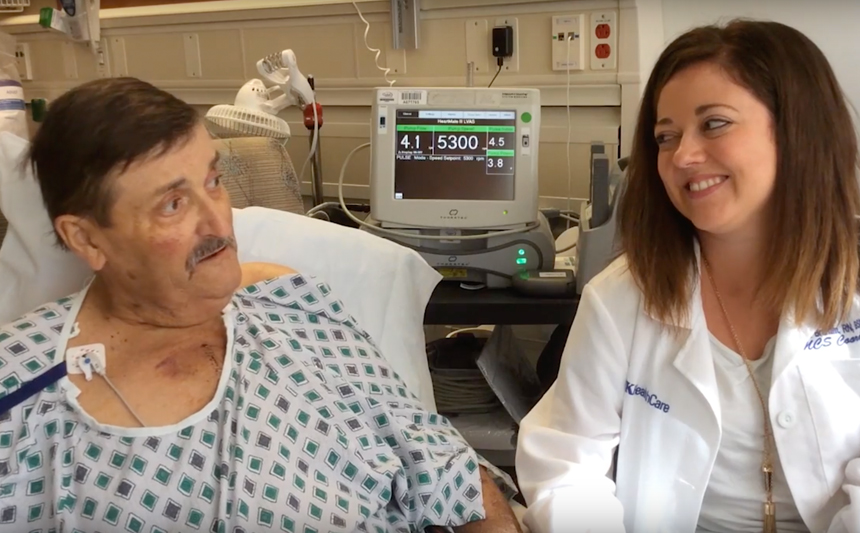Hometown connection leads to life-saving heart procedure

Jim Lester encourages others to listen to his heart. As you adjust the stethoscope’s earpieces and lean in, you hear an electronic whir and zing reminiscent of a video game. The sound that startles others makes Lester laugh. Apparently this is not the first time he’s unleashed this parlor trick.
Just two weeks prior, Lester was gravely ill, in end-stage heart failure, the result of a lifetime of repeated heart attacks (three), blood clots (four) and a stroke. His ejection fraction – a measure of the heart’s ability to pump blood – was less than 20 percent. A healthy person’s EF sits in the 50 to 70 percent range.
Lester remembers the conversation with Alexis Shafii, his physician at the Gill Heart Institute. “Dr. Shafii was straight to the point,” Lester remembers. “He said that I had to have an LVAD in order to survive.”
A left ventricular assist device, or LVAD, is a mechanical device that helps a weakened heart pump blood. “An LVAD doesn’t replace the heart,” said Dr. Maya Guglin, medical director of Mechanical Circulatory Support at the UK Gill Heart Institute. “It just helps it do its job.” However, Guglin was cautious. Implanting an LVAD requires open heart surgery and a lifetime of maintenance. It’s not a good fit for every patient.
A common connection
Lester was afraid of surgery. He kept asking whether there were any pills that could help him instead of this strange-looking machine. Then he met Sarah Branam, one of the three LVAD coordinators at the Gill.
“The team asked me to do some education with Jim, since he was very standoffish about the idea of having an LVAD,” Branam said. “I started discussing with him what his fears were with the LVAD, I just wanted to help relieve his concerns. And I always say, ‘Where are you from?’ and when he said, ‘Maysville, Kentucky,’ I was like, ‘Well, funny thing, so am I!'”
They bonded instantly. Lester knew Branam’s “Papaw,” Clarence Branam, and then knew he could trust Sarah. She understood Lester’s fear of the unknown, but she could also share her experiences with many patients with LVADs.
“I got to see patients go from being in the ICU, and being as sick as they are, to see them with quality of life: the stamina, no oxygen tank, being able to walk farther, getting back to what they wanted to do… it was just amazing,” Branam explained.
“I was awful scared, but after talking to Sarah and finding out she comes from Maysville, why, everything leveled out,” Lester said tearfully. “This little thing came in, and she would answer any questions I had, and took all my fears away.”
Even better: Lester qualified for a clinical trial to implant a new version of an LVAD called HeartMate 3.
The power of advanced medicine through clinical trials
According to Guglin, the HeartMate 3 is a tremendous improvement from its predecessor with a longer battery life, smaller profile and engineering that minimizes the potential for complications like blood clots and GI bleeds.
“That the Gill was included in this major clinical trial was a coup for us,” Guglin said. “It’s a signal that the cardiology world recognizes our expertise, our professionalism and our teamwork.”
And, Guglin adds, this also helps fulfill the heart institute’s academic mission, since high-profile trials like that for the HeartMate 3 expose Gill trainees to the newest available technology – technology that could become standard treatment by the time they are in their own practice.
On Aug. 8, Lester was implanted with the HeartMate 3. Everyone noticed immediately how improved he was.
“The biggest thing I saw about Jim before the surgery was how hard he was struggling to breathe. And the day after the breathing tube was pulled out, he did not need supplemental oxygen,” Branam said.
“It felt like I was getting too much oxygen,” Lester laughs.
A new lease on life
After a couple of weeks of recovery and therapy, Lester was discharged. What will he do with this new lease on life?
“Well, I aim to go home, sit on my front porch, watch the traffic go up and down the street, and hug my wife,” Lester said.
Lester was the Gill’s first HeartMate 3 patient, but three others followed within 10 days. This phase of the trial is now closed, but the UK will be involved in the next phase, a “Continued Access Protocol” that permits all qualifying patients to receive the HeartMate 3 while FDA approval is pending.
Based on her initial involvement with the HeartMate 3 trial, Guglin has great hopes for the device.
“It’s an amazing feeling when you come to see the patient next morning after the surgery and their skin color is different and there is life in them,” she said. “And when they are being discharged 10 days or two weeks later it’s gratifying to see how much they improved on your watch because of the intervention you were able to offer.”




